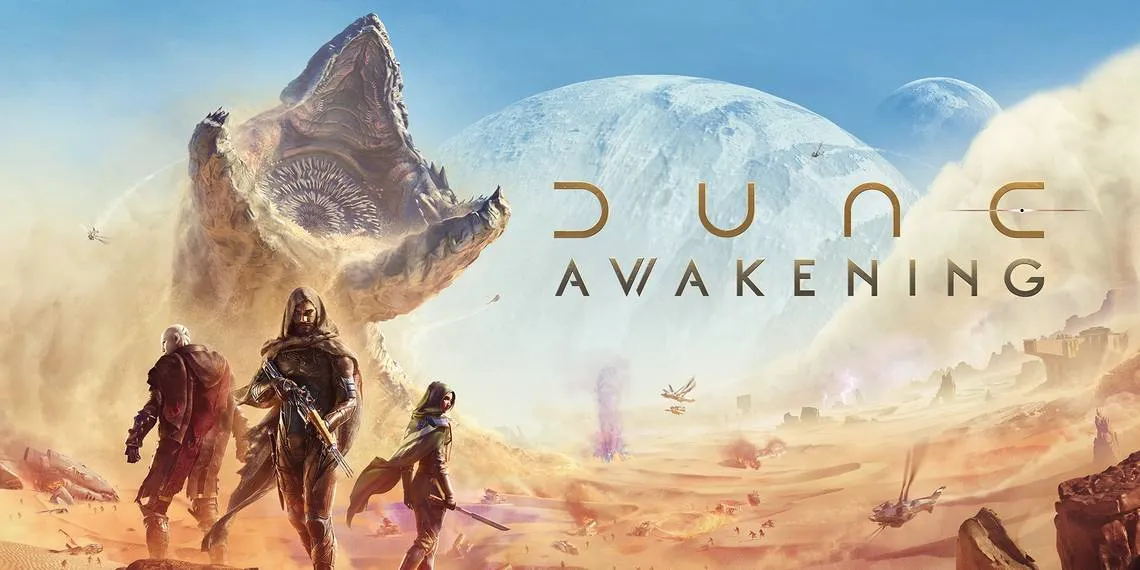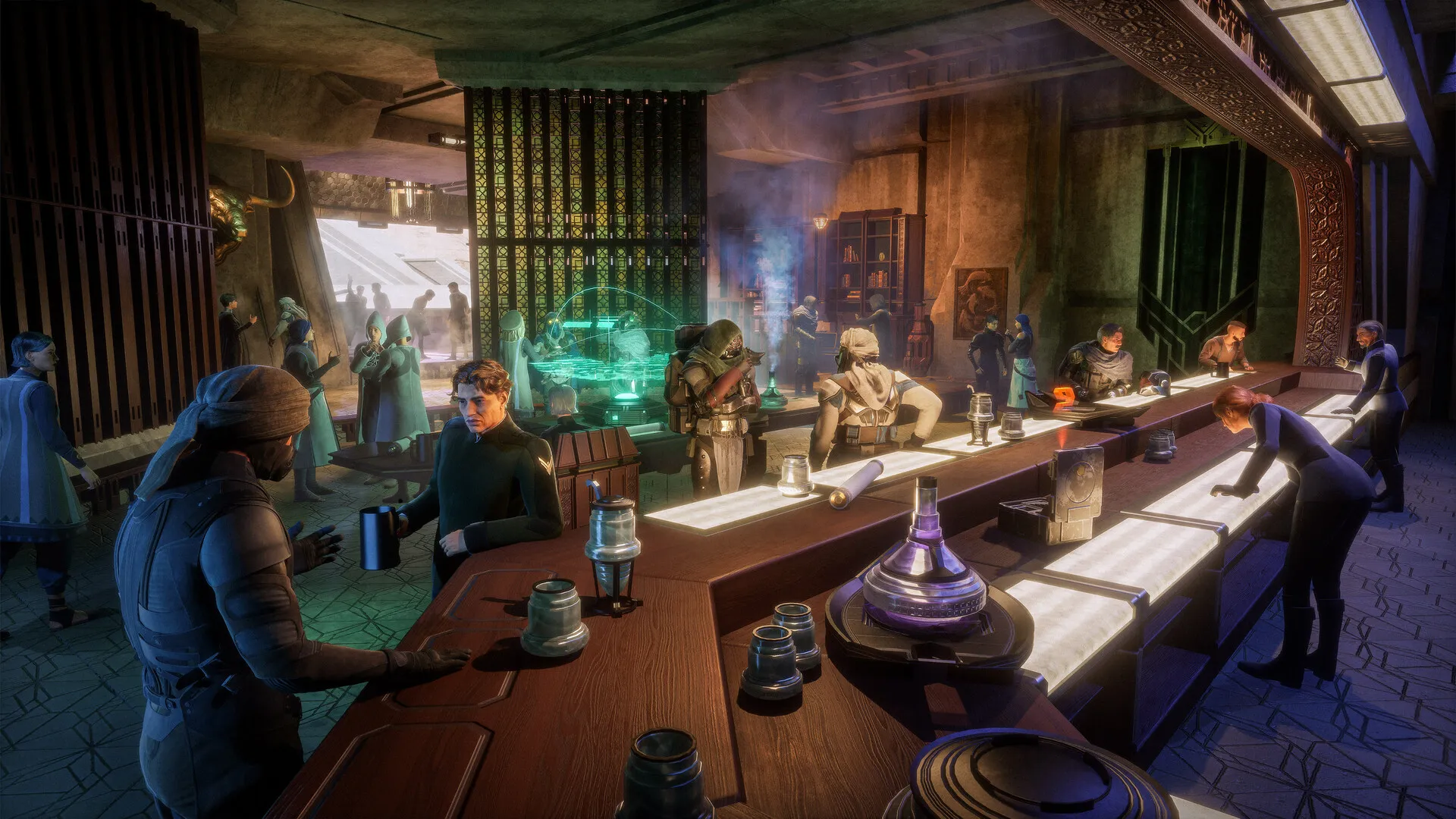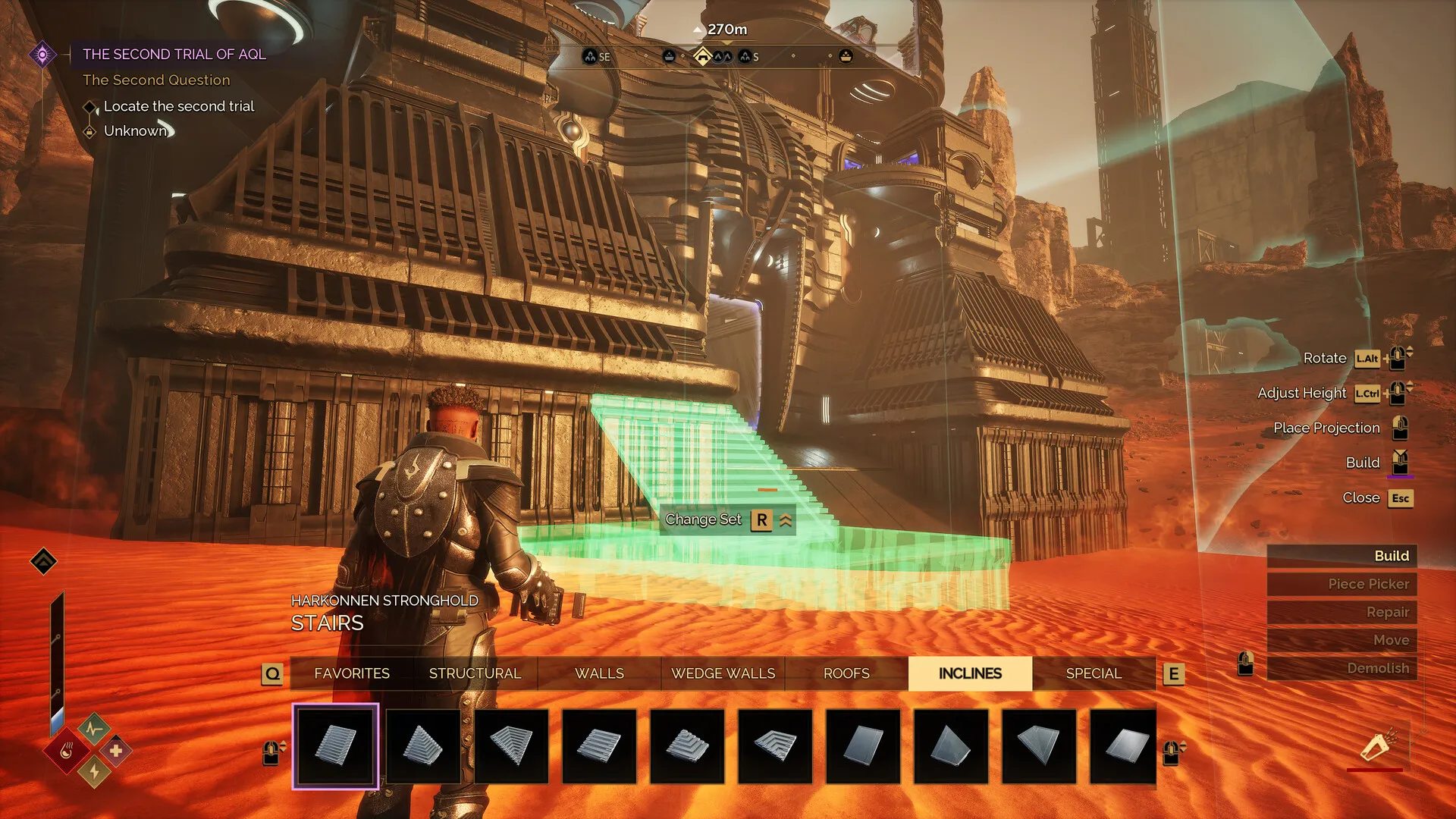The planet Arrakis is a legend; a world of endless sand, searing sun, and the priceless spice that fuels an empire. It is a place where life is measured in drops of water and survival is a daily struggle against a landscape that actively wants you dead. Dune: Awakening drops you onto this iconic world, presenting itself as an open-world survival MMO that leverages every bit of that brutal reputation.
The game immediately establishes a fascinating premise for anyone familiar with the source material: this is not the Arrakis of the books or films. It exists in an alternate timeline where Paul Atreides was never born, where Lady Jessica instead gave birth to a daughter, and Duke Leto survived the Harkonnen betrayal.
This single divergence creates a reality ripe for conflict. The Fremen have been hunted nearly to extinction, and the great houses are locked in a bitter war for control. You enter this volatile setting as your own custom character, an off-worlder tasked with navigating the treacherous political currents and the even more treacherous environment. Your purpose is simple, yet profound: endure the planet, find your place among its powerful factions, and carve out an existence on the most dangerous world in the universe.
The World of Arrakis: Beauty and Brutality
Funcom’s depiction of Arrakis is, without question, a visual spectacle. Leveraging Unreal Engine 5, the game delivers breathtaking desert landscapes that stretch to the horizon, all under a sky scorched by a relentless sun. The lighting effects are particularly impressive, casting long, dramatic shadows that are not just for show but are a core part of the survival mechanics.
This visual fidelity is complemented by a masterful soundscape; the score sets a tone of mystery and grandeur, while the environmental audio—the whisper of wind over a dune, the distant roar of a storm—creates a palpable sense of place. The world feels ancient and scarred, littered with the half-buried wreckage of past conflicts and the crumbling remnants of forgotten outposts.
This beauty is a deceptive veil for a planet that is actively hostile. The environment’s lethality is most apparent in its two major dynamic threats: Coriolis storms and the legendary sandworms. Witnessing a colossal storm front roll across the plains is a terrifying sight, a wall of sand and lightning that shreds anything left exposed. More iconic, however, are the sandworms.
The ground trembles, a deep roar echoes, and you have mere seconds to scramble for the safety of high rock before a behemoth erupts from the sand to consume you. The game makes these encounters truly dreadful by attaching severe penalties. While most deaths allow you to retrieve your gear, being devoured by a worm or lost to a storm means your entire inventory is gone forever. This permanent loss is a harsh but effective mechanic that instills a genuine fear of the open desert.
For fans of the source material, this version of Arrakis may feel somewhat unfamiliar. In a necessary concession to the MMO format, the planet is far more populated than its literary counterpart. The landscape is dotted with scavenger camps, other player bases, and a surprising amount of flora from which to harvest resources.
The sheer availability of scrap metal and other materials makes the planet feel less like a barren wasteland and more like a contested frontier, closer in spirit to a place like Tatooine from Star Wars than the desolate world Frank Herbert described. These decisions make for a more engaging gameplay loop, but they do trade some of the planet’s iconic desolation for a more accessible survival experience.
The Art of Survival
While many survival games saddle you with a suite of meters to manage, Dune: Awakening smartly streamlines its focus onto mechanics that feel authentic to its setting. There are no hunger or rest bars to worry about. Instead, your existence is governed by two primary concerns: water and sun.
The hydration system is relentlessly demanding; your water level constantly ticks down, and as it depletes, your maximum health decreases with it until death becomes inevitable. This forces a constant search for moisture, whether you are harvesting dew from sparse desert flora or engaging in the grim but necessary act of drawing blood from fallen enemies to run through a purifier.
Compounding this is the Sunstroke mechanic. Lingering in direct sunlight builds up a meter that inhibits skill usage, slows stamina recovery, and accelerates hydration loss. This elegantly simple system transforms the landscape itself into a puzzle, forcing you to plan your movements from one patch of shadow to the next or to risk traveling only under the relative safety of the night sky.
Where the game truly excels is in its crafting and base-building loop. It begins simply enough, gathering scrap metal and granite to fashion basic tools and weapons. Soon, however, you will be laying the foundations of a permanent base, and it is here that the system reveals its impressive depth and polish. Reminiscent of Fallout 76’s C.A.M.P. system but arguably more refined, the building interface is smooth, with components that snap into place intuitively.
The library of available pieces is vast, offering everything from functional walls and foundations to decorative pillars and rounded windows, allowing for genuine architectural expression. This isn’t just for aesthetics; your base is a complex machine.
You must manage a network of fueled generators powering water purifiers, which in turn supply ore refineries. This interconnectedness demands thoughtful planning, and a well-designed base with a protected garage is essential for sheltering vehicles and yourself from the daily Coriolis storms.
As with many titles in the survival-crafting genre, including Funcom’s previous MMO Conan Exiles, the progression curve steepens considerably over time. While the early hours feel rewarding and manageable, the resource requirements for mid-to-late game technology become immense.
Crafting high-tier gear and base components demands a significant investment in resource gathering, a process that can feel like a considerable grind. This is especially true for solo players, who will feel the weight of these material costs most acutely. The gameplay loop shifts from one of discovery to one of dedicated, repetitive harvesting to fuel your advancement.
Forging an Identity
Character creation in Dune: Awakening goes far beyond skin-deep customization. While the visual creator offers a respectable suite of options, the most meaningful choices are narrative. At the outset, you define your character’s background by selecting a home planet, a societal caste, and a mentor.
These are not mere flavor text; they have tangible consequences that ripple through your playthrough, determining your starting abilities, unlocking unique dialogue options, and granting access to specific perks down the line. This approach gives your character an immediate foothold in the lore, grounding your personal story within the larger conflict from the very first moments.
This foundation is built upon with a flexible and deep specialization system. Players begin by choosing one of four starting disciplines: the analytical Mentat, the precise Swordmaster, the enigmatic Bene Gesserit, or the disciplined Trooper, with a fifth class, the Planetologist, available to be unlocked through gameplay.
Each class features multiple skill trees, allowing for significant customization within a chosen path, and a generous respec timer lets players experiment without fear of permanent commitment. The system’s most compelling feature, however, is the ability to discover new mentors scattered across Arrakis.
By completing their unique quests, you can learn skills from other disciplines, effectively allowing you to create powerful hybrid builds that mix and match abilities from different schools of thought. This freedom to craft a truly unique playstyle is one of the game’s greatest strengths.
Your identity is further defined by your political allegiance. Eventually, you will have the opportunity to align with either House Atreides or House Harkonnen, a choice that opens up faction-specific quests, exclusive crafting schematics, and unique building components for your base.
This system adds another layer to the experience, transforming the personal struggle for survival into a contribution to a server-wide war. This political dimension culminates in the Landsraad system, a fascinating mechanic that allows powerful guilds and players to vote on decrees, buffs, and even weapon blueprints that affect the entire server, adding a dynamic political landscape on top of the environmental threats.
The Friction of Combat
If Dune: Awakening excels in world-building and survival systems, its combat is where the experience begins to show some friction. The system serves its basic purpose as a way to break up the loop of gathering and crafting, but it lacks the polish found elsewhere in the game.
It introduces promising, lore-appropriate ideas, such as teaching players to dodge, parry, and utilize a special “Slowblade” attack designed to bypass personal energy shields—a concept taken straight from the novels. On paper, this suggests a thoughtful, tactical system, but in practice, the execution feels underdeveloped.
The most significant issue is a fundamental imbalance that heavily favors ranged playstyles. A vast majority of the enemies you encounter will engage you from a distance with firearms, leaving melee-focused characters at a distinct disadvantage. The tools to effectively close the distance are limited, meaning you often have to absorb significant damage just to get into striking range.
This design choice has a ripple effect, as it also neuters the viability of stealth. With most encounters favoring open, ranged engagements, the opportunities for a quiet, surgical approach are few and far between. This stands in contrast to many other survival titles where various combat approaches are more equally supported.
This imbalance is compounded by a general lack of satisfying feedback. Melee combat, in particular, often feels stiff and unresponsive, with clunky animations that make encounters feel more like a chore than a thrilling duel. At times, the enemy AI can be slow to react to your presence, breaking the immersion of a fight before it even begins.
While the variety of enemy armaments—from grenades and machine guns to sniper rifles—can still present a genuine threat and force you to be cautious, the underlying mechanics often feel more superficial than deep, leaving the combat as the most noticeable area in need of refinement.
The MMO Experience
Considering the turbulent history of MMO launches, Dune: Awakening arrives in a surprisingly polished state. Performance is remarkably consistent, and the experience is largely free of the game-breaking bugs that often plague new releases in this genre.
That is not to say it is flawless; minor glitches like occasionally clipping through terrain or getting stuck during a climb can momentarily disrupt the immersion. However, the inclusion of a built-in “unstuck” feature shows a welcome foresight from the developers.
A more structural concern lies with the server architecture. The strict 40-player limit per server and the potential to be placed in a queue when returning from an instanced mission create an occasional bottleneck that can interrupt the flow of play.
The core gameplay loop is driven by a contract system, where players can accept a variety of missions from boards located in settlements. These tasks are diverse enough to keep things interesting, ranging from reconnaissance and sabotage to simple deliveries.
While these contracts provide a steady stream of objectives, the highlight of the questing experience is the story-driven mentor quests. These more involved missions are required to unlock new skill trees and do an excellent job of weaving narrative progression into tangible character growth.
Ultimately, these systems encourage a wide spectrum of social interaction. Players can form squads to brave the desert’s dangers together, engage in the server-wide political struggle between the great houses, or test their combat skills against others in the dedicated “Deep Desert” PvP zone. This blend of cooperative and competitive play provides multiple avenues for players to leave their mark on the world.
The Review
Dune: Awakening
Dune: Awakening is a stunning achievement in world-building and survival design, capturing the brutal beauty of Arrakis with remarkable success. Its demanding survival mechanics, polished base-building, and flexible character progression create a deeply compelling loop. However, this excellent foundation is significantly undermined by a clunky, unbalanced combat system that feels like an afterthought. The experience is an incredible survival sandbox bolted to a mediocre action game. It’s a world worth living in, so long as you can tolerate the friction of fighting for it.
PROS
- A visually stunning and deeply atmospheric depiction of Arrakis.
- Engaging survival mechanics that feel authentic to the setting.
- Extensive and polished base-building system with deep customization.
- Flexible character progression allowing for unique hybrid builds.
- Impressively stable technical performance for a new MMO.
CONS
- Combat is stiff, unresponsive, and heavily imbalanced.
- Significant late-game resource grind is required for progression.
- Deviations from established lore may not appeal to purists.
- Server player caps and queuing can occasionally interrupt gameplay.



















































